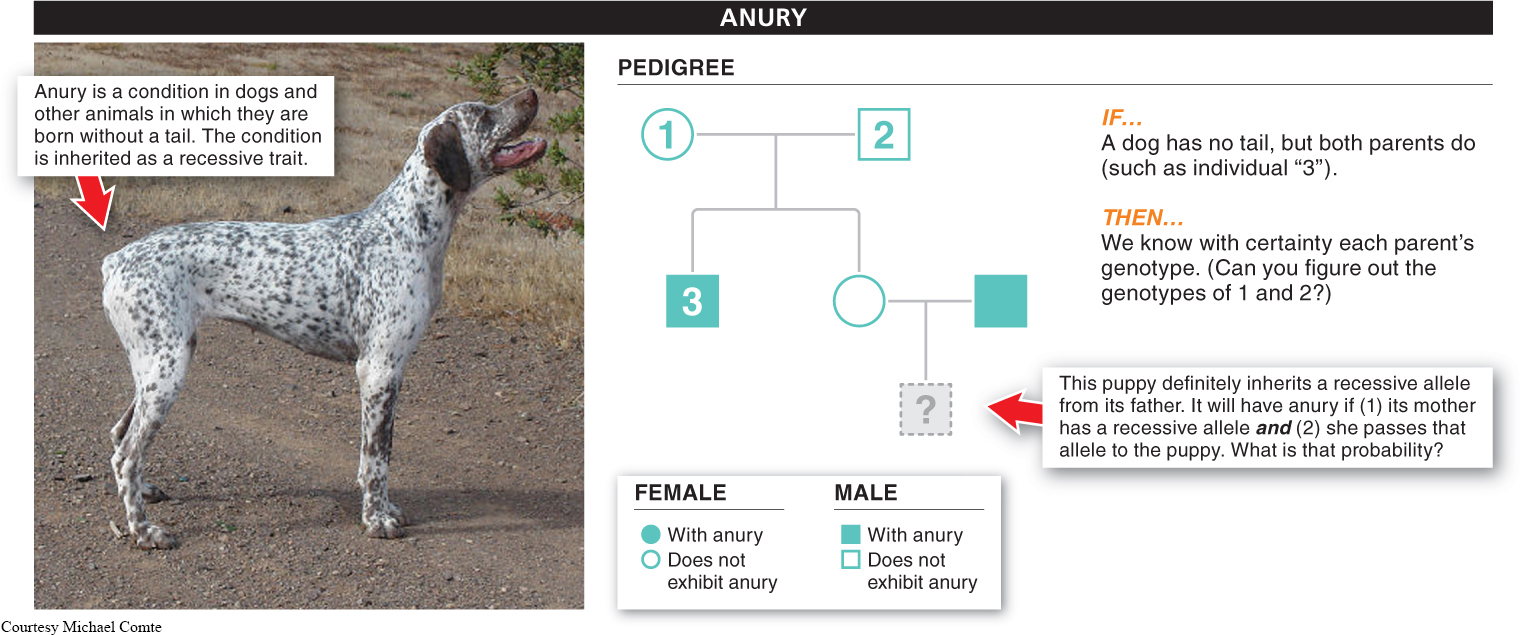People want to know things about the future, such as: What is the likelihood that I will have a child with a particular genetic disease, say hemophilia? Or what is my own risk of developing a genetic disease, such as Huntington’s disease, later in my life? Geneticists who study these and other diseases want to know other things: How is a particular disease or trait inherited? Is it recessive or dominant? Is it carried on the sex chromosomes or on one of the other chromosomes? A pedigree is a type of family tree that can help answer these questions.
Why do breeders value “pedigreed” horses and dogs so much?
Dog and horse breeders often speak of “pedigreed” animals, a feature that adds tremendous value to the animals. This is because, with knowledge of an animal’s family tree, or complete lineage, it is much less likely that any genetic surprises will occur as the animal develops and reproduces.
In a pedigree, information is gathered from as many related individuals as possible across multiple generations (FIGURE 7-16). Starting from the bottom, each row in the chart represents a generation, listing all of the children in their order of birth, their sex, and whether or not they have a particular trait. Working up the pedigree, the children’s parents are indicated and, above them, their parents’ parents, for as far back as data are available. Squares represent males and circles represent females, and these shapes are shaded to indicate that an individual exhibits the trait of interest. Sometimes the genotype (as much of it as is known) is also listed for each individual.

By analyzing which individuals manifest the trait and which do not, it may be possible to deduce a pattern of inheritance for the trait—
The pedigree can also help to determine whether a trait is carried on the sex chromosomes (X or Y, which we discuss in Section 7-
An example of how pedigrees can help determine how traits are inherited is given in FIGURE 7-17. Anury is a condition seen in dogs and some other animals in which the animal has no tail. The pedigree reveals that anury is inherited as a recessive trait, because unaffected parents can have offspring with the disorder.

Can you determine the genotype of the individual labeled “1” in Figure 7-
On the same pedigree, note that two individuals in the second row of the pedigree have a puppy (indicated by “?”). What is the probability that this puppy has anury? Examine the pedigree carefully and see whether you can come up with the answer; the next paragraph will guide you through if you get stuck.
292
In the cross producing the mystery puppy, the father has anury and so must be homozygous recessive; he will definitely pass on one a to the son. The mother’s genotype can be AA, Aa, or aA, given that both of her parents are heterozygous. Consequently, she has a ⅔ (2 in 3) probability of being a carrier of the a allele. If she is, then there is a ½ (50%) chance that she will pass the allele on to her offspring, and he will have anury. The probability, therefore, is ⅔ × ½ = ⅓, or a 1 in 3 chance that the puppy will have anury.
Researchers often use plants and small insects to study inheritance patterns—
As we’ll discuss in later sections of this chapter, some traits may not show complete dominance and many traits are also influenced by the environment, so it is not always completely obvious what a trait’s mode of inheritance is. In such cases, the more individuals we can include in the pedigree, the more accurate the analysis. Some human pedigrees contain thousands of individuals and stretch back six or more generations. With some other species it is possible to analyze tens of thousands of individuals per generation for a dozen or more generations. This is why plants and small insects (among other organisms) are excellent for studying inheritance patterns.
Once we have an idea about how a trait is inherited, we can identify individuals who are carriers of a recessive trait and make informed predictions about a couple’s risk of having a child with a particular disorder. This knowledge can be useful in conjunction with prenatal testing and treatment.
TAKE-HOME MESSAGE 7.8
Pedigrees help scientists, doctors, animal and plant breeders, and prospective parents determine the genes that individuals carry and the likelihood that the offspring of two individuals will exhibit a given trait.
What is a pedigree? Why would this information be useful to doctors, prospective parents, or plant/animal breeders?
A pedigree is a type of family tree that is used to explore inheritance patterns for genetic information carried in a group of related individuals. This information can be used to examine: likelihood that individuals will have a particular genetic disease; risks of developing a genetic disease; how particular diseases or traits are inherited; characteristics of genetic traits, such as inheritance patterns of recessive and dominant alleles; and whether a genetic trait is carried on the sex chromosomes or one of the other chromosomes. This type of information would be useful for doctors exploring genetic disease patterns, parents who are worried about passing on genetic diseases to their children and/or developing genetic diseases themselves, as well as plant/animal breeders seeking to produce plants/animals with specific genetic traits.
293